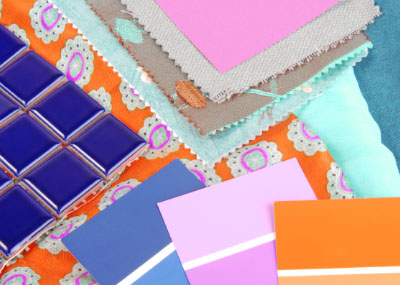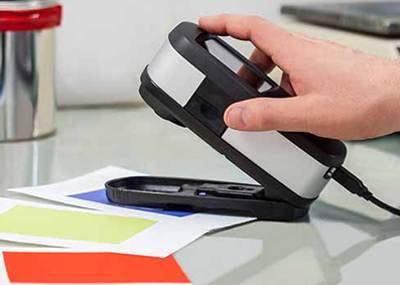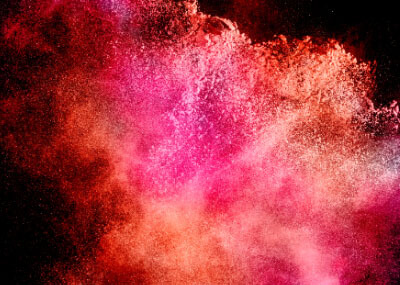Tragbare Spektralfotometer von X-Rite
Leichte und tragbare Spektralfotometer sind eine praktische Lösung für die Farbmessung von Proben. Ein tragbares Spektralfotometer ist ein äußerst nützliches Tool zur Farbmessung und Erfassung der Farbdaten auf verschiedensten Substraten in einer Druckmaschine, in einem Labor, an einer Laderampe oder unterwegs. Die tragbaren Spektralfotometer von X-Rite werden mit verschiedenen Geometrien zur konstanten und präzisen Farbmessung verschiedenster Proben angeboten. Sehen Sie sich unser Sortiment unten an, oder setzen Sie sich mit unserem Team in Verbindung, um das für Ihre Geschäftsanforderungen am besten geeignete tragbare Spektralfotometer auszuwählen.
Tragbare Spektralfotometer mit Kugelgeometrie von X-Rite
Mit ihren präzisen Farbmessungen sorgen die kompakten und leichten tragbaren Kugelspektralfotometer von X-Rite für höchste Farbqualität in jeder Phase der Produktion in diversen Branchen.

eXact™-Serie, tragbare Spektralfotometer und Densitometer
Mit innovativen Funktionen wie der marktweit ersten, patentierten Mantis Video Targeting- und Digital Loupe-Zoomtechnologie ist das eXact 2 die optimale Lösung für Druckdienstleister, Verpackungs- und Farbhersteller.

Tragbare Mehrwinkel-Spektralfotometer von X-Rite
Die tragbaren Mehrwinkel-Spektralfotometer von X-Rite vereinen Farbabbildung mit Mehrwinkel-Technologie zur präzisen Messung von Effektfarben und -lacken.

Tragbare 45/0-Spektralfotometer
Tragbare 45/0-Spektralfotometer von X-Rite sollen zahlreiche Farbanforderungen von Kunden im Farbenhandel und in anderen Branchen erfüllen.

Tragbare Spektralkolorimeter
Tragbare Spektralkolorimeter von X-Rite sollen zuverlässige Farbvergleiche für Materialien und Produkte bieten, bei denen eine Farbkontrolle unverzichtbar ist.

eXact-Familie der 1. Generation
Trotz der Markteinführung des neuen eXact 2 werden die Vorgängermodelle eXact Basic, eXact Basic Plus, eXact Standard, eXact Advanced, eXact Xp und eXact mit Scan-Option von X-Rite noch hergestellt und gewartet. Mehr dazu.
Arten von tragbaren Spektralfotometern
Ein tragbares Spektralfotometer ist ein kompaktes Gerät und ideal zur Farbmessung und Prüfung von Toleranzen für die Qualitätskontrolle und -sicherung. Kompakte Spektralfotometer sind in verschiedenen Formen und Größen erhältlich. Allerdings ist die zu messende Oberfläche der wichtigste Aspekt beim Kauf eines Spektralfotometers.
Gründe für ein tragbares Spektralfotometer mit Kugelgeometrie
Die Farbmessung auf reflektierenden Oberflächen kann ein schwieriges Unterfangen sein, weil sich die Farbwirkung durch den Glanzeffekt ändern kann. Ein Kugelspektralfotometer misst das aus allen Winkeln reflektierte Licht zur Berechnung von Farbwerten, die der vom menschlichen Auge wahrgenommenen Farbe sehr ähnlich sind. In der Regel kommt es zur Farbmessung auf strukturierten Oberflächen, wie Textilien, Teppichen und Kunststoffen, sowie glänzenden oder spiegelartigen Oberflächen, wie u. a. Metallic-Farben, bedruckten Folien und anderen stark glänzenden Flächen, zum Einsatz.
Innen hat ein Kugelspektralfotometer eine stark reflektierende, weiße Oberfläche mit einer Lichtquelle dahinter. Eine Ablenkplatte verhindert, dass Licht direkt auf die Probe fällt, sodass sie diffus beleuchtet wird. Probe und Glanzwinkel werden vom Detektor in einem Winkel von 8° von der Senkrechten betrachtet. An dieser Stelle befindet sich die Glanzmessöffnung bzw. Glanzfalle. Die Referenzstrahlöffnung überwacht die Kugelwand, um Beleuchtungsänderungen zu berücksichtigen.
Ein Spektralfotometer mit Kugelgeometrie hat die Leistungsmerkmale eines konventionellen Tischspektralfotometers und bietet zwei Messmodi: SPIN (mit Glanzeinschluss) und SPEX (ohne Glanzeinschluss). Im SPIN-Modus bleibt die Glanzfalle geschlossen. Im SPEX-Modus ist die Glanzfalle geöffnet, damit die Glanzkomponente die Kugel verlassen kann. Die Textur und/oder Glanzwirkung von Proben können sehr unterschiedlich sein, insbesondere bei reflektierenden Materialien, Textilien und textilen Materialien. Bei einer SPIN-Messung wird die Farbe ohne Berücksichtigung von Glanz oder Textur gemessen, wohingegen eine SPEX-Messung das gesamte Erscheinungsbild mit allen optischen Eigenschaften einer Probe erfasst.
Mit ihrem robusten Design sind die Labor-Spektralfotometer der Ci60-Serie von X-Rite hervorragend für den Einsatz in anspruchsvollen Umgebungen geeignet. Sie bieten eine intuitive Benutzeroberfläche mit leicht ablesbarer Pass- bzw. Fail-Anzeige. Der einfache Wechsel zwischen mittlerer und kleiner Messblende (4 und 8 oder 14 mm) ermöglicht flexiblere Messungen verschiedenster Proben. Zur präzisen Messung von schwer zu haltenden Proben können sie mit speziellem Zubehör, wie Küvetten- und Kartenhaltern, ausgestattet werden.
Die Ci60-Serie reicht vom Standalone-Ci60 bis zum Spitzenmodell Ci64 für äußerst präzise Messungen. Das Ci64 ist in drei Modellvarianten erhältlich und bietet gleichzeitige SPIN/SPEX-Messungen, korrelierte Glanzwerte und eine UV-Option zur präzisen und effizienten Messung von unebenen Oberflächen auf verschiedensten Produkten und Verpackungstypen.
Gründe für ein tragbares Mehrwinkel-Spektralfotometer
Komplexe Effektlackierungen tragen zwar zur Produktdifferenzierung bei, erschweren jedoch auch die Farbmessung und -kontrolle. Zur Messung von Effektmaterialien und Gewährleistung der Übereinstimmung von benachbarten Komponenten benötigen Sie ein Mehrwinkel-Spektralfotometer zur Charakterisierung von Farbe, Sparkle und Coarseness.
Ein Mehrwinkel-Spektralfotometer nimmt die Farbmessung so vor, als würden Sie die Probe drehen, um die Probenfarbe aus verschiedenen Winkeln zu betrachten. Diese Geräte werden für die Messung von Pigmentfarben mit spezieller Beschichtung und Effektfarben mit Zusatzstoffen wie Glimmer und Perlglanz, z. B. Nagellack oder Fahrzeuglackierungen, verwendet.
Die bedienerfreundlichen Mehrwinkel-Spektralfotometer der MA-Serie von X-Rite setzen neue Maßstäbe für die Messung von Effektlackierungen. Sie erfassen Farbe, Sparkle und Coarseness noch präziser und einfacher als je zuvor. Das mit einer RGB-Kamera und einer Weißlichtquelle ausgestattete MA nimmt Probenmessungen auf Effektlackierungen vor und bietet eine leicht ablesbare Pass- bzw. Fail-Anzeige, die der Farbwahrnehmung des menschlichen Auges entspricht.
Die Modelle der MA-Serie zeichnen sich durch ihr ergonomisches, benutzerfreundliches Design aus und verfügen über eine mittig angeordnete Messblende mit 3 Positionierungsstiften, die für stabile Messungen sorgen. Dank der intuitiven Touchscreen-Navigationsführung und Live-Vorschau des Messbereichs können Sie sicher sein, dass Sie die Messung am richtigen Punkt vornehmen. Mit ihrem robusten Design und einem bequemen Griff sind die Modelle der MA-Serie zur präzisen Farbmessung in anspruchsvollen Produktionsumgebungen bestens geeignet.
Gründe für ein tragbares Spektralfotometer mit 45°/0°-Geometrie
Dieses Spektralfotometer kommt am häufigsten zum Einsatz. Dieses Gerät misst das in einem festgelegten Winkel zur Probe, i.d.R. 45°, reflektierte Licht und kann Glanz ausschließen, um die menschliche Farbwahrnehmung bestmöglich zu imitieren. Meist dienen diese Geräte zur Farbmessung auf glatten oder matten Oberflächen, wie Papier in Druck- und Verpackungsanwendungen.
Seit Jahren ist die eXact-Familie das Nonplusultra für die Farbmessung in der Druck- und Verpackungsindustrie. Mit seiner einfachen Benutzeroberfläche und dem intuitiven Touchscreen-Display ist dieses tragbare Spektralfotometer mit 45°/0°-Geometrie das ideale Tool für viel beschäftigte Druckdienstleister. Ohne lästige Kabel und mit kabelloser Kalibrierung, Spezifikation und Datenerfassung ist das eXact überall zur Erfassung und Speicherung von Daten ohne Netzteil geeignet. Da die Daten im Gerät gespeichert sind, lassen sich Jobeinstellungen und Farbbibliotheken mit nur einem Klick aufrufen.
Angefangen von einem einfachen Densitometer bis zu einem hochmodernen Farbmanagement-Tool wird das X-Rite eXact in mehreren Modellvarianten angeboten, um den individuellen Anforderungen jedes Kunden gerecht zu werden. Bei Änderung dieser Anforderungen lassen sie sich jederzeit auch problemlos aufrüsten.
Sind Sie immer noch nicht sicher, welches Gerät für Sie das richtige ist? Dann sollten Sie sich mit uns in Verbindung setzen, um mit einem Farbexperten über Ihre speziellen Anforderungen an ein tragbares Spektralfotometer zu sprechen.
Laden Sie dieses Whitepaper herunter, um zu erfahren, welche Art von Spektralfotometer für Sie am besten geeignet ist, basierend auf der zu messenden Oberfläche.
Ein Spektralfotometer kann Ihnen bei der verlässlichen Farbgebung und Farbkommunikation helfen. Diese nützlichen Ressourcen helfen Ihnen bei der Einrichtung und optimalen Nutzung Ihres Spektralfotometers.
In diesem kostenlosen 10-minütigen Webinar erfahren Sie, warum ein Mehrwinkel-Spektralfotometer die ideale Lösung zur Messung von Oberflächen mit Spezialeffekten wie Metallic- und Perlglanz-Farben ist.



